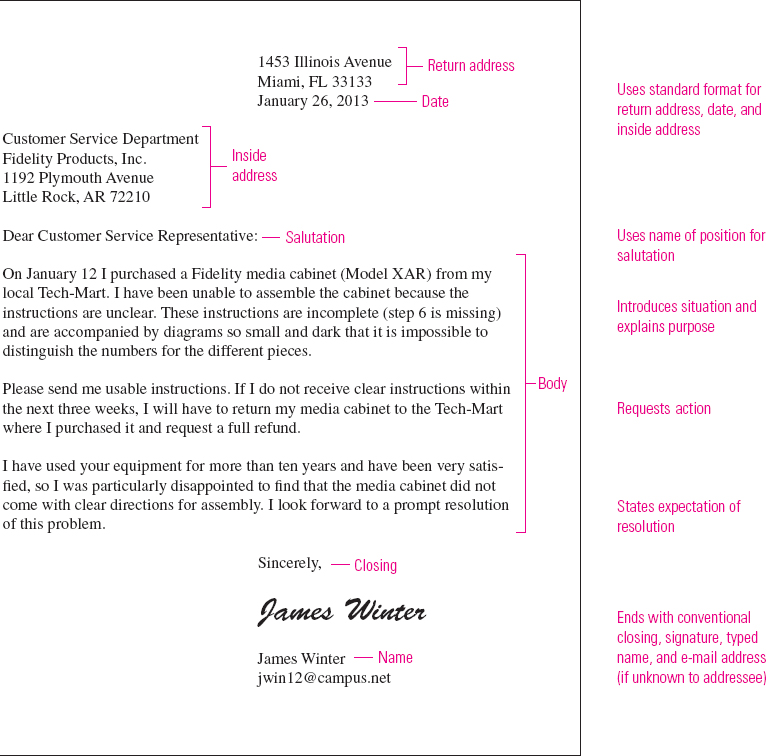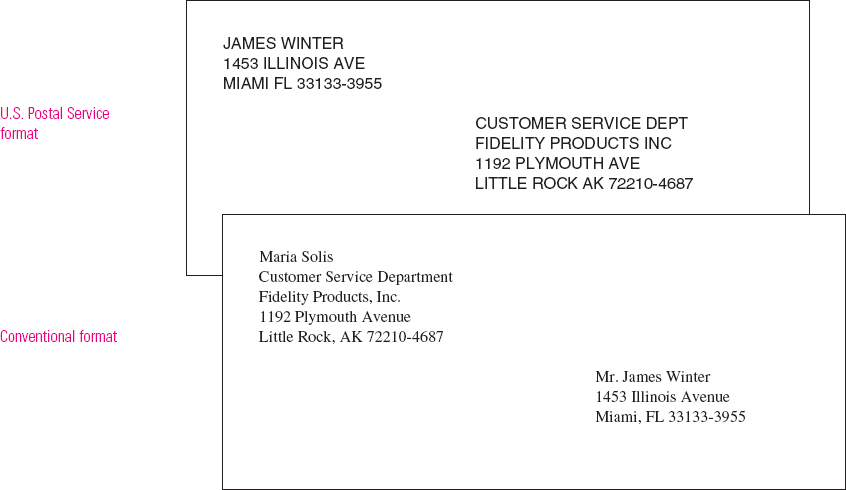Format for Business Letters
The format of business letters (see Figure 17.4) is established by convention.
- Use 81⁄2-by-11-inch bond paper, with matching envelopes. Write on only one side of the page.
- Single-space and use an extra line of space to separate paragraphs and the different elements of the letter. In very short letters, it’s acceptable to leave additional space before the inside address.
- Leave margins of at least one inch on both sides; try to make the top and bottom margins fairly even, although you may have a larger bottom margin if your letter is very short.
- Pay attention to grammar, punctuation, spelling, and mechanics. Your readers will.
Return Address. This is your address or the address of the company for which you are writing. Abbreviate only the state using its two-letter postal abbreviation. Omit a return address on preprinted letterhead stationery.
Date. Supply this on the line right after the return address. Spell out the month; follow it by the day, a comma, and the year.
Inside Address. This is the address of the person to whom you are writing. Begin with the person’s full name and title (Mr., Ms., Dr., Professor); when addressing a woman without a professional title, use Ms. unless you know that she prefers Miss or Mrs. The second line should identify the position the person holds, and the third line should name the organization. If you don’t know your reader, start with the name of the position, department, or organization. Avoid abbreviations except for the state.
Salutation. Skip a line. Then type Dear followed by the person’s title and last name (Dear Dr. Diaz). If you don’t know who will read your letter, use that person’s position (Dear Editor) or organization (Dear Angell’s Bakery) in place of a name. End with a colon.
Body. Present your message. Leave one line of space between paragraphs; begin each paragraph even with the left margin (no indentations). Paragraphs should generally be no longer than seven or eight typed lines.
Closing. Leave one line of space after the last paragraph, and then use a conventional closing followed by a comma: Sincerely, Sincerely yours, Respectfully yours, Yours truly.
Typed Name with Position. Leave four lines of space after the closing, and type your name in full, even if you will sign only your first name. Do not include a title before your name. If you are writing on behalf of an organization, you can include your position on the next line. You may add your e-mail address or telephone number here unless already supplied.
Signature. Print the letter, and sign your name in the space above the typed name. Unless you have a personal relationship with the recipient, use both your first and last names. Do not include a title before your name.
Abbreviations at End. Leave at least two lines of space between your typed name and any abbreviations used to communicate more about the letter. Put each abbreviation on a separate line. If you send a copy to someone other than the recipient, use cc: followed by the name of the person or organization receiving a copy. If the letter is accompanied by another document in the same envelope, use Enc. or Enclosure. If the letter has been typed by someone else, the writer’s initials are capitalized, followed by a slash and the typist’s initials in lowercase format: VW/dbw.
Modified and Full Block Style. To format a letter using modified block style (see Figure 17.4), imagine a line running down the center of the page from top to bottom. Align the left side of the return address, date, closing, signature, and your typed name with this center line. Use full block style on letterhead stationery with the organization’s name and address. Omit typing the return address, and align all elements at the left margin.


Envelope Formats. The U.S. Postal Service recommends an easy-to-scan format with all capital letters, standard abbreviations, and no punctuation. However, conventional format (see Figure 17.5) is always safe to use.